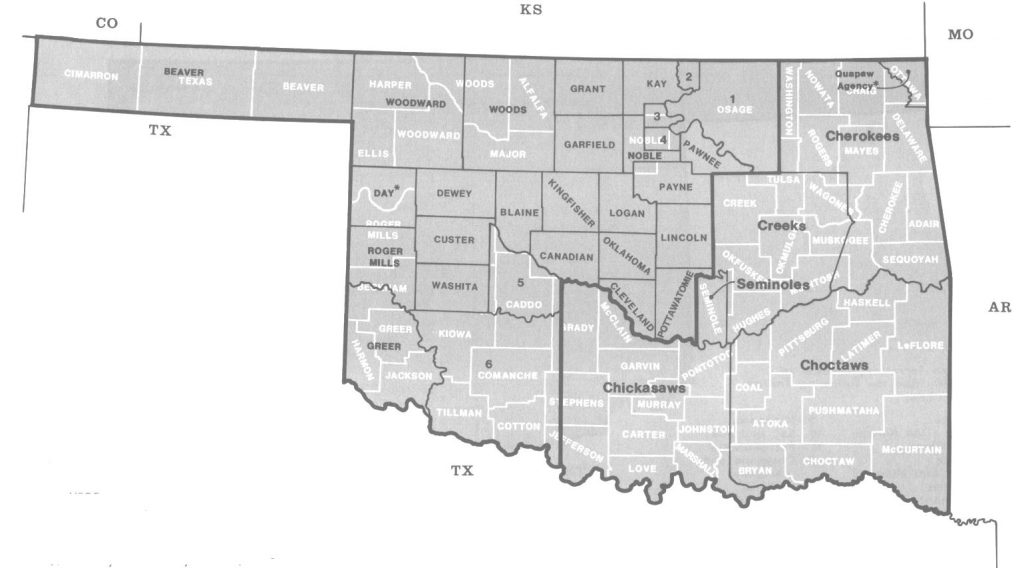 The following article is by my friend Bill Dollarhide, taken from his book, Oklahoma Censuses & Substitute Name Lists, 1828-2012.
The following article is by my friend Bill Dollarhide, taken from his book, Oklahoma Censuses & Substitute Name Lists, 1828-2012.
Prologue: The term Indian Country was used to describe the western areas encompassing several Indian tribes, whether nations, reservations, or those roaming free over the Great Plains. The evolution of the Indian Country into an official Indian Territory took place over much of the 19th Century. However, Indian Territory was never a territory in the official sense of the term. For the entire period of its existence, it never had a combined territorial government or a federally appointed territorial governor. This essay is presented as a loose timeline of events from the first removals of Eastern Indians up to the 1907 admission of the state of Oklahoma.
1804. First Wave of Removals. Soon after the 1803 Louisiana Purchase, Thomas Jefferson urged the resettling of tribes of the eastern United States on the newly acquired lands west of the Mississippi. In 1804, Congress passed legislation authorizing the negotiation of removal treaties with the eastern tribes, and over the next twenty years, several tribes or portions of tribes moved west. The first phase of removal was mostly voluntary, mostly peaceful, but often conflicted with white settlers moving west of the Mississippi at the same time.
Aftermath of the War of 1812 and Creek War. Cherokees, Creeks, and others of the five civilized tribes were to pay dearly for their support of the British Army during the War of 1812. And, after the Creek War of 1813-1814, the American government voided treaties, took lands away, and forcibly sent Indians West. This movement was sponsored by General Andrew Jackson, who rode a wave of resentment against the Indians into the White House.
1819-1821. Areas supposedly set aside for Indians was compromised further when Arkansas Territory was established in 1819, it included most of the area of present-day Oklahoma. And in 1821, Missouri was admitted to the Union, further reducing the perceived range of land that was to be dedicated to the relocation of eastern Indian tribes.
In 1828, the present western boundary of Arkansas was drawn, and for the first time, the law described the area west of that line as the exclusive domain of Indian tribes. But, its jurisdiction was still part of the larger area officially called Unorganized Territory, an area that extended from the Red River of the South (present Texas) to the Red River of the North (present Minnesota). Due to a misunderstanding of the Arkansas boundary, early white settlers north of the Red River (in present-day McCurtain County, Oklahoma) thought they were living in old Miller County, Arkansas Territory. In 1828, several hundred families were moved to areas south of the Red River to vacate the newly defined Indian domain. This was a rare case in American history where whites were relocated to make room for Indians – it was usually the other way around.
In the early 1830s, forced removal of eastern Indian tribes continued, the most notorious being the Cherokee removal, which history remembers as the “trail of tears.” During this period, the majority of the five civilized tribes moved to new reservations in the Indian Country.
In 1834, Congress defined “Indian Country” as any portion of the western United States that was not part of a state or territory, thus, Indian Country was the same as Unorganized Territory. The new law also regulated certain activities of non-Indians within the region and established judicial boundaries: the northern portion of the region (modern Kansas) was to be under the control of the federal courts of Missouri; the southern portion (modern Oklahoma), under the federal courts of Arkansas. Federal censuses in the Indian Country taken from 1820 through 1870 for non-Indians were under the jurisdiction of the Missouri and Arkansas federal marshals. (Indians were specifically excluded from the federal censuses, except those who lived off reservations and subject to taxes like non-Indians). In the Indian Country, the most populous of the tribes were located in the southern portion, namely, the relocated Choctaw, Cherokee, Chickasaw, Creek, and Seminole Nations (the Five Civilized Tribes). To the north in present-day Kansas were the reservations of numerous small Midwestern and Plains tribes.
1854. Second Wave of Removals. The next removals and concentration of Indian populations took place in 1854, when twelve treaties were negotiated with tribes living in the northern part of the Unorganized Territory. Together, these agreements opened most of present-day Kansas for white settlement. That same year Congress created Kansas Territory, which encompassed the remaining tribes and their diminished reservations. As a result, the Indian Country was reduced to the area of present-day Oklahoma (except for the Panhandle) with most of the land owned by the Five Civilized Tribes.
1860 Federal Census. Evidence of non-Indians living in the Indian Country can be seen in the 1860 federal census, where whites, blacks, adopted, or intermarried persons living on “Indian Lands West of Arkansas” were named and listed at the end of the Arkansas census schedules.
Aftermath of the Civil War Era. In 1865, because the governments of the Five Civilized Tribes had supported the South during the Civil War, the U.S. federal government declared void its existing treaties with the five tribes. New treaties were negotiated the following year, in which the tribes either ceded the western portions of their lands to the federal government for the resettlement of more Indians, or, in the case of the Cherokees, provided for the sale of their western lands (the Cherokee Outlet).
1865-1885. Third Wave of Removals. A third wave of removals began when the government in 1865 started moving remaining tribes from Texas, Kansas, Nebraska, and elsewhere into the southern region (present Oklahoma). This is where the newly ceded western lands of the Five Civilized Tribes were now available for Indian settlement. During this time, the Cheyenne and Arapaho, the Comanche, Kiowa, and Apache, the Wichita and Caddo, the Potawatomi and Shawnee, the Kickapoo, the Iowa, the Sauk and Fox, the Pawnee, the Oto and Missouri, the Ponca, the Tonkawa, the Kaw, the Osage, the Peoria, the Wyandot, the Eastern Shawnee, the Modoc, and the Ottawa reservations were established in the Indian Country.
1872. Indian Territory. In the Osage Reservation Act of 1872, the law stated that the reservation was located in Indian Territory, and all subsequent tribal agreements, executive orders, and other federal actions relative to the region now referred to the area officially as Indian Territory.
1887-1906. Indian Allotments. In 1887, Congress passed the General Indian Allotment Act, which initiated the process of dividing tribal property and dissolving tribal agreements. Subsequent allotment acts by 1906 had essentially ended tribal land ownership in present-day Oklahoma, with allotments of land divided among individual Indians. Records of the allotments, including a final “census” of the families involved, provides the most complete list of inhabitants of the Indian Territory for that time period.
In 1889, Congress established a separate federal court at Muskogee for Indian Territory, and for the first time it officially defined the area’s boundaries: Indian Territory was the area bounded by the states of Kansas, Missouri, Arkansas, and Texas and the Territory of New Mexico. On April 22 the Unassigned Lands were opened to settlement by non-Indians in the first of the famous land runs. Over fifty thousand homesteaders settled in the region on that day. (Try that today without computers!)
In May 1890, Indian Territory was divided into Oklahoma Territory and Indian Territory. Oklahoma Territory was defined as incorporating the Unassigned Lands and all reservations, with the exception of those of the Five Civilized Tribes and a few small reservations. While all of the reservations in the Cherokee Outlet (the panhandle) were to be part of Oklahoma Territory, that portion of the Outlet still owned by the Cherokee Nation would remain as part of Indian Territory until purchased by the government. Almost immediately a special commission was organized to negotiate the allotment of the reservations in Oklahoma Territory and the sale of unallotted lands so that they could be opened for non-Indian settlement.
1890-1900 Censuses. Special censuses were taken periodically for Indians, and in the 1890 and 1900 federal censuses, Indian tribes were enumerated with population schedules added to the regular schedules for each territory or state (1890 lost, 1900 extant).
In 1893 the Cherokees sold their remaining portion of the Outlet, which was immediately incorporated into Oklahoma Territory and opened for settlement. Thus by 1893 Indian Territory had been reduced to just the reservations of the Five Civilized Tribes proper and the small reservations in the northeast. Also in 1893, the Dawes Commission was created by Congress to negotiate agreements with the Five Civilized Tribes to allot their lands,
In 1898 the allotment process began in what remained of Indian Territory.
1900. Map of Oklahoma Territory & Indian Territory. This map shows in black, the counties and Indian jurisdictions of Oklahoma Territory and Indian Territory at the time of the June 1900 Federal Census. The current 77 counties of the state of Oklahoma are shown in white. Oklahoma Territory, created in May 1890, had the following Indian jurisdictions: 1) Osage, 2) Kaw (alias Kansas), 3) Ponca, 4) Otoe and Missouri, 5) Wichita, and 6) Kiowa, Comanche, and Apache. Census Availability: The 1900 federal census is extant for all counties and Indian jurisdictions. The Poncas and Otoe/Missouri were enumerated in Noble County, Oklahoma Territory. Map Source: Page 278, Map Guide to the U.S. Federal Censuses, 1790-1920.
In 1905, an attempt was made to maintain some semblance of continued Indian separation. Leaders of the Five Civilized Tribes organized a constitutional convention, drew up a constitution, and asked to be admitted to the Union as the state of Sequoyah. Congress rejected the plan.
In 1907 Congress approved a statute that joined Indian Territory with Oklahoma Territory to create the new state of Oklahoma.
Censuses for Indian Territory, Oklahoma Territory, and Oklahoma
Several censuses were taken by the Five Civilized Tribes separate from the federal censuses or those taken by Oklahoma Territory. This included censuses taken in 1880 and 1890 by the Cherokee government; an 1885 Choctaw census; and an 1890 census by the Chickasaw tribe. The Indian censuses identify both Indians and non-Indians living on their reservations.
The 1890 federal census included population schedules for the newly formed Oklahoma Territory, and added the Indian tribes of Indian Territory on separate schedules. Unfortunately, most of the 1890 federal censuses were burned or destroyed after a fire in the Commerce Building in Washington, DC in 1921. But some relief to the 1890 disaster exists, since Oklahoma Territory took a special territorial census in 1890 for its original seven counties (Beaver, Canadian, Cleveland, Kingfisher, Logan, Oklahoma, and Payne), which all survive.
The 1900 federal census for Oklahoma Territory included separate population schedules for Indians.
1907 Special Federal Census. Just prior to statehood in 1907, the federal government sponsored a census for Indian and Oklahoma territories. However, of the 75 counties enumerated, only the name list for Seminole County survives at the National Archives.
Further Reading:
Oklahoma Censuses & Substitute Name Lists, 1828-2012 (Printed Book), Softbound, 87 pages, Item FR0281.
Oklahoma Censuses & Substitute Name Lists, 1828-2012 (PDF eBook), 87 pages, Item FR0282.
Online Oklahoma Censuses & Substitutes: A Genealogists’ Insta-Guide™, Laminated, 3-hole punched,
4 pages, Item FR0351.
Online Oklahoma Censuses & Substitutes: A Genealogists’ Insta-Guide™ (PDF version), 4 pages, Item FR0352.
